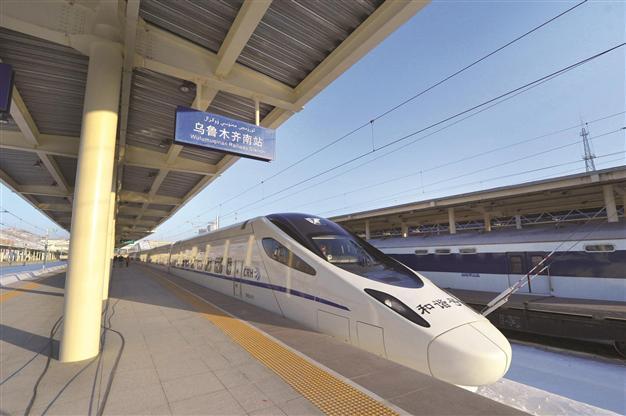China’s new Silk Road initiative attracts Turkey’s attention
Umut Ergunsü* BEJING

The first ever direct China-Spain freight train, which started its journey from Yiwu, a major trading hub south of Shanghai, traveled an epic 13,000 kilometers in 21 days. AFP photo.
The first ever direct China-Spain freight train - which started its journey from Yiwu, a major trading hub south of Shanghai - travelled an epic 13,000 kilometers in 21 days (10 days faster than the conventional ocean freight), reaching Madrid in December 2014. The inauguration of a direct train link between Yiwu and Madrid should be seen as part of China’s ambitious foreign policy initiative to revive the ancient Silk Road.The New Silk Road initiative consists of a network of both land and sea routes. The land route, the “Silk Road Economic Belt,” is planned to traverse Eurasia using three sub routes (north, middle and south).
The sea route, the “21st Century Maritime Silk Road,” will extend from eastern China to Southeast Asia, East Africa, the Middle East and Europe. In order to improve the infrastructure along these Silk Road routes, China will not only contribute $40 billion to set up a Silk Road Fund, but also provide up to 50 percent of the total capital ($100 billion) to establish the Asian Infrastructure Investment Bank (AIIB).
Background Factors
International and domestic factors affecting China’s decision to revive the Silk Road are little known to foreigners. Professor Wang Yong, the director of the Center for International Political Economy Research in Peking University, believes that after the 2008 global financial crisis, changes in the international political and economic structure started to accelerate. The BRICS, where Chinese economy is larger than that of the four other members combined, were responsible for 55 percent of global growth between 2009 and 2012 (23 developed countries only contributed 20 percent to global growth during the same period). Regional free trade agreements, like the Trans-Pacific Partnership (TPP) and the Transatlantic Trade and Investment Partnership (TTIP), as well as the Obama administration’s “pivot to Asia,” have played an important role in formulating the initiative.
The most important domestic factors are the consequences of China’s economic rise and the challenges of economic rebalancing. China’s share of global trade increased from less than 1 percent in 1978 to 12 percent in 2012, surpassing the U.S. as the world’s largest trading nation.
After two decades of rapid growth, however, China’s economy has eventually entered a “new normal” stage, and the country’s economy is set to grow more slowly. As recently announced, China grew only 7.4 percent in 2014, marking its lowest rate in 24 years. Apart from slowing growth, chronic over-capacity is also one of the biggest challenges facing the Chinese economy. Steel, flat glass, cement, electrolytic aluminum and shipbuilding are all identified as having severe excess capacity.
Main objectives
The projects could help China to use its massive foreign exchange reserves more effectively, reform and open up and thus increase the scale and momentum of economic development, deepen China’s economic integration into the world economy, achieve industrial upgrading and sustainable development, increase China’s energy security, and allow China more room for strategic maneuver.
According to Professor Justin Yifu Lin, the former Chief Economist and Senior Vice President of the World Bank, with “One Belt, One Road” China will also “help developing countries to overcome growth bottleneck and help them create the right conditions for economic development.”
This ambitious initiative also faces numerous challenges, such as uncertainty in dealing with the countries along the Silk Road that differ in size, political systems, legal systems, development levels and cultural traditions. Some of those countries’ bilateral relations are complex for historical and political reasons, and Chinese companies’ lack of international experience also poses important challenges. To overcome those challenges, China as the initiator must ensure close cooperation and coordination between relevant agencies.
Effects on Turkish-Sino bilateral relations
In 2008, (five years before China initiated the “One Belt, One Road” initiative), Turkey, together with Azerbaijan, Iran, Georgia, Kazakhstan and Kyrgyzstan (in 2014, China, as Turkey’s strategic partner, also agreed to participate) launched the “Silk Road Initiative and Caravanserai Project,” aimed at facilitating border crossings along the route of the historic Silk Road through the simplification and harmonization of customs procedures.
As can be expected, Turkey has expressed interest in “One Belt, One Road” and has said it is evaluating it positively. At the same time, it is cautious because it needs to learn more about Chinese intentions. In order to better understand each other’s position, Turkey and China have already held meetings and conferences to discuss the initiative. According to Professor Selçuk Çolakoğlu, an advisor for the Turkish Foreign Ministry’s Center for Strategic Research (SAM), Turkey and China are the two most eager countries in integrating the Silk Road region.
However, Turkish-Sino collaboration in integrating the Silk Road region also faces challenges such as uncertainty over the two countries’ differing approaches to the Uyghur issue and deterrent pressure on Turkey exerted by NATO.
It still is too early to state that the Turkish-Sino relationship is harkening back to the age of the ancient Silk Road, but converging interests in reviving the ancient Silk Road will lead to closer and more regular collaboration in areas such as transportation infrastructure, energy, security and tourism. It is therefore clear that “One Belt, One Road” will have a positive effect on furthering Turkish-Chinese strategic partnership.
*Umut Ergunsü is a PhD student at Peking University’s School of International Studies.











